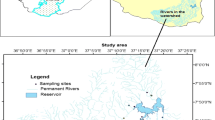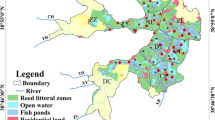Abstract
Excessive organic matter and nutrients can depress dissolved oxygen concentration (DOC) in streams. The aim of this study was to understand the depressed DOC of Kickapoo Creek in Texas, USA, which is an impaired stream; identify the possible sources causing the depressed DOC and elevated Escherichia coli levels; and identify possible remedial measures. Monthly grab water quality data was monitored for nine stations in the watershed. For three of the nine stations, 24-h DOC was also monitored for a comparison with the minimum and average DOC criteria. Correlational, graphical, spatial, and temporal analyses were carried out for DOC concentration with other water quality variables which have the potential to depress DOC in the stream. The correlational analyses show a weak to moderate correlation for DOC with nutrient and oxygen-demanding substance concentrations present in the stream. However, there are spatial and temporal trends in DOC data that can be attributed to the nutrient influx into the stream. A pattern of increasing nutrient concentrations from upstream to downstream partially explains the decreasing dissolved oxygen (DO) concentrations observed towards the lower reaches. Visual interpretations of riparian vegetation and sediment influx also support the spatial patterns in DO concentrations. The majority of the depressed DOC occurs in the summer months when streamflow is at a minimum. The depressed DOC during summer is partially explained by the increasing daily temperatures for the summer months as revealed by the trend analysis of the daily temperature data from 1981 to 2020 using the modified Mann–Kendall test, Pettitt test, and Sen’s slope.










Similar content being viewed by others
Explore related subjects
Discover the latest articles, news and stories from top researchers in related subjects.Data availability
Data used in the study is available on request.
Code availability
Not applicable.
References
Abbott, M. B., Bathurst, J. C., Cunge, J. A., O’Connell, P. E., & Rasmussen, J. (1986). An introduction to the European hydrological system—Systeme Hydrologique Europeen, ‘SHE’. 2: Structure of a physically-based, distributed modelling system. Journal of Hydrology, 87, 61–77. https://doi.org/10.1016/0022-1694(86)90115-0
Arnold, J. G., Allen, P. M., Muttiah, R., & Bernhardt, G. (1995). Automated base flow separation and recession analysis techniques. Ground Water, 33, 1010–1018.
ASABE (American Society of Agricultural and Biological Engineers) Standards. (2005). Manure Production and Characteristics. D384.2, St. Joseph, MI.
Average Size of Households in the United States in 2019, by State https://www.statista.com/statistics/242265/average-size-of-us-households-by-state/ . Accessed 8 September 2021.
AVMA (American Veterinary Medical Association). (2018). U.S. Pet Ownership Statistics. Online at: https://www.avma.org/resources-tools/reports-statistics/us-pet-ownership-statistics . Accessed 29 March 2021.
Bailey, R. Y., & Ahmadi, M. (2014). Spatial and temporal variability of in-stream water quality parameter influence on dissolved oxygen and nitrate within a regional stream network. Ecol Modell, 277, 87–96. https://doi.org/10.1016/j.ecolmodel.2014.01.015
Brown, L. C., Barnwell, T. O. (1987) The enhanced stream water quality models QUAL2E and QUAL2E-UNCAS: Documentation and user manual. EPA/600/3–87/007, US EPA, Athens, Georgia.
Calculating Oxygen Percent Saturation, https://projects.ncsu.edu/cals/course/zo419/oxygen.html. Accessed 8 September 2021.
Chen, D., Hu, M., Guo, Y., & Dahlgren, R. A. (2016). Changes in river water temperature between 1980 and 2012 in Yongan watershed, eastern China: Magnitude, drivers and models. Journal of Hydrology, 533(2016), 191–199. https://doi.org/10.1016/j.jhydrol.2015.12.005
Connolly, N. M., Crossland, M. R., & Pearson, R. G. (2004). Effect of low dissolved oxygen on survival, emergence, and drift of tropical stream macroinvertebrates. Journal of the North American Benthological Society, 23(2), 251–270. https://doi.org/10.1899/0887-3593(2004)023%3c0251:EOLDOO%3e2.0.CO;2
Cox, B. A. (2003). A review of currently available in-stream water-quality models and their applicability for simulating dissolved oxygen in lowland rivers. Science of the Total Environment, 314–316, 335–377. https://doi.org/10.1016/S0048-9697(03)00063-9
Dodds, W. K., Tromboni, F., Saltarelli, W. A., & Cunha, D. G. F. (2017). The root of the problem: Direct influence of riparian vegetation on estimation of stream ecosystem metabolic rates. Limnology and Oceanography Letters, 2(2017), 9–17. https://doi.org/10.1002/lol2.10032
Ducharne, A. (2008). Importance of stream temperature to climate change impact on water quality. Hydrology and Earth System Sciences, 12, 797–810. https://doi.org/10.5194/hess-12-797
Ficklin, D. L., Stewart, I. T., & Maurer, E. P. (2013). Effects of climate change on stream temperature, dissolved oxygen, and sediment concentration in the Sierra Nevada in California. Water Resources Research, 49, 2765–2782. https://doi.org/10.1002/wrcr.20248
Gebreslase, A. (2017). Relative linkages of stream dissolved oxygen with environmental drivers across the Gulf Coast of USA. MS Thesis, West Virginia University.
Gelca, R., Hayhoe, K., Scott-Fleming, I., Crow, C., Dawson, D., & Patino, R. (2016). Climate-water quality relationships in Texas reservoirs. Hydrological Processes, 30, 12–29. https://doi.org/10.1002/hyp.10545
Gu, C. H., Anderson, W. P., Jr., Colby, J. D., & Coffey, C. L. (2014). Air-stream temperature correlation in forested and urban headwater streams in the Southern Appalachians. Hydrological Processes, 29(6), 1110–1118. https://doi.org/10.1002/hyp.10225
Hamed, K. H., & Rao, A. R. (1998). A modified Mann-Kendall trend test for autocorrelated data. Journal of Hydrology, 204(1–4), 182–196. https://doi.org/10.1016/S0022-1694(97)00125-X
Harris, I., Osborn, T. J., Jones, P., Lister, D. (2020). Version 4 of the CRU TS monthly high-resolution gridded multivariate climate dataset. Scientific Data, 7. https://doi.org/10.1038/s41597-020-0453-3
Harris, J. O., Maguire, G. B., Edwards, S. J., & Johns, D. R. (1999). Low dissolved oxygen reduces growth rate and oxygen consumption rate of juvenile greenlip abalone. Haliotis Laeõigata Donovan, Aquaculture, 174, 265–278. https://doi.org/10.1016/S0044-8486(99)00022-8
https://www.911.gov/. Accessed 1 April 2021.
https://www.statista.com/statistics/242265/average-size-of-us-households-by-state/. Accessed 1 April 2021.
Huang, J., Yin, H., Chapra, S. C., & Zhou, Q. (2017). Modelling Dissolved oxygen depression in an urban river in China. Water, 9, 520. https://doi.org/10.3390/w9070520
Ice, G., & Sugden, B. (2003). Summer Dissolved Oxygen Concentrations in Forested Streams of Northern Louisiana. Southern Journal of Applied Forestry, 27(2), 92–99. https://doi.org/10.1093/sjaf/27.2.92
Ice, G. G., Hale, V. C., Light, J. T., Muldoon, A., & Simmons, A. (2021). Understanding dissolved oxygen concentrations in a discontinuously perennial stream within a managed forest. For Ecol Manag, 479, 118531. https://doi.org/10.1016/j.foreco.2020.118531
Irby, I. D., Friedrichs, M. A. M., Da, F., & Hinson, K. E. (2018). The competing impacts of climate change and nutrient reductions on dissolved oxygen in Chesapeake Bay. Biogeosci, 15, 2649–2668. https://doi.org/10.5194/bg-15-2649-2018
Jamieson, D. G., & Fedra, K. (1996). The ‘WaterWare’ decision-support system for river-basin planning. 2: Planning capability. Journal of Hydrology, 177, 177–198. https://doi.org/10.1016/0022-1694(95)02957-5
Kramer, D. L. (1987). Dissolved oxygen and fish behavior. Environmental Biology of Fishes, 18(2), 81–92.
Morrill, J. C., Bales, R. C., & Conklin, M. H. (2005). Estimating stream temperature from air temperature: Implications for future water quality. Journal of Environmental Engineering, 131(1), 139–146. https://doi.org/10.1061/(ASCE)0733-9372(2005)131:1(139)
Nas, S. S., Bayram, A., Nas, E., & Bulut, V. N. (2008). Effects of Some Water Quality Parameters on the Dissolved Oxygen Balance of Streams. Polish J of Environ Stud, 17(4), 531–538.
Nielson-Gammon, J. W. (2011). The changing climate of Texas. The impact of global warming on Texas (2nd ed., pp. 39–68). University of Texas Press.
Null, S. E., Mouzon, N. R., & Elmore, L. R. (2017). Dissolved oxygen, stream temperature, and fish habitat response to environmental water purchases. Journal of Environmental Management, 197, 559–570. https://doi.org/10.1016/j.jenvman.2017.04.016
Ogejo, J. A., Wildeus, S., Knight, P., & Wilke, R. B. (2010). Estimating goat and sheep manure production and their nutrient contribution in the Chesapeake Bay Watershed. Applied Engineering in Agriculture, 26(6), 1061–1065. https://doi.org/10.13031/2013.35912
Saari, G. N., Wang, Z., & Brooks, B. W. (2018). Revisiting Inland Hypoxia: Diverse Exceedances of Dissolved Oxygen Thresholds for Freshwater Aquatic Life Environmental Science and Pollution Research, 25, 3139–3150. https://doi.org/10.1007/s11356-017-8908-6
Sanches, E., Colmenarejo, M. F., Vicente, J., Rubio, A., Garcia, M. G., Travieso, L., & Borja, R. (2007). Use of the water quality index and dissolved oxygen deficit as simple indicators of watersheds pollution. Ecological Indicators, 7(2), 315–328. https://doi.org/10.1016/j.ecolind.2006.02.005
Texas Commission on Environmental Quality (TCEQ). 2020. Texas Integrated Report of Surface Water Quality for the Clean Water Act Sections 305(b) and 303(d). https://www.tceq.texas.gov/waterquality/assessment/20twqi. Accessed 29 March 2021.
Texas Water Resources Institute (TWRI). (2018). Escherichia coli and dissolved oxygen trends in the Upper Llano River Watershed, Texas (2001–2016). TWRI Technical Report-511, College Station, Texas.
The Federal Clean Water Act, 1972, 33 U.S.C. §1251 et seq. (1972).
TNRIS (Texas Natural Resources Information System). https://tnris.org/. Accessed 1 April 2021.
TxDOT. (2021). City Boundaries Dataset http://gis-txdot.opendata.arcgis.com/datasets/txdot-cityboundaries. Accessed 1 April 2021.
Unmuth, J. M., Lillie, R. A., Dreikosen, D. S., & Marshall, D. W. (2000). Influence of dense growth of eurasian watermilfoil on lake water temperature and dissolved oxygen. Journal of Freshwater Ecology, 15(4), 497–503. https://doi.org/10.1080/02705060.2000.9663772
USCB, United States Census Bureau. (2019). Census 2019 Data, Washington D.C. Census Block Data available at: https://www.census.gov/quickfacts/tylercitytexas. Accessed 29 March 2021.
USDA National Agricultural Statistics Service. (2017). Census of Agriculture. Complete data available at: www.nass.usda.gov/AgCensus. Accessed 29 March 2021).
van Vliet, M. T. H., Yearsley, J. R., Franssen, W. H. P., Ludwig, F., Haddeland, I., Lettenmaier, D. P., & Kabat, P. (2012). Coupled daily streamflow and water temperature modelling in large river basins. Hydrology and Earth System Sciences, 16, 4303–4321. https://doi.org/10.5194/hess-16-4303-2012
Whitehead, P. G., Williams, R. J., & Lewis, D. R. (1997). Quality simulation along river systems (QUASAR): Model theory and development. Science of the Total Environment, 194(195), 447–456. https://doi.org/10.1016/S0048-9697(96)05382-X
Womble, S. (2018). Animal Unit Equivalent Chart – Texas Domestic Livestock, Native Wildlife, and Exotic Wildlife https://agrilife.org/agnewsandviews/2018/06/11/animal-units-chart/. Accessed 16 September 2021.
Acknowledgements
The authors thank Texas Institute for Applied Environmental Research (TIAER) for the water quality data collection and lab analysis, Angelina Neches River Authority (ANRA) for analyzing bacteria in the water samples, and Texas State Soil and Water Conservation Board (TSSWCB) for funding the study.
Funding
This study is funded by the Texas State Soil and Water Conservation Board (TSSWCB), USA.
Author information
Authors and Affiliations
Contributions
Narayanan Kannan conceptualized the technical part of the study, carried out the depressed dissolved oxygen and bacteria analysis, and wrote a significant portion of the manuscript. Kartik Venkataraman carried out the climate change analysis, related that with the depressed dissolved oxygen issue, and wrote an appreciable portion of the manuscript, Jeff Strobel collected field observations and Leah Taylor obtained the funding and managed the project.
Corresponding author
Ethics declarations
Ethics approval
Not applicable.
Consent to participate
Not applicable.
Consent for publication
Not applicable.
Conflict of interest
The authors declare no competing interests.
Additional information
Publisher's Note
Springer Nature remains neutral with regard to jurisdictional claims in published maps and institutional affiliations.
Highlights
• Dissolved oxygen concentration (DOC) data of Kickapoo Creek in Texas, USA, was analyzed.
• Analyses found other water quality parameters, with the potential for affecting DOC, helped explain observed DOC patterns.
• Declining dissolved oxygen (DO) concentrations were observed from upstream to downstream and during the summer months.
Supplementary Information
Below is the link to the electronic supplementary material.
Rights and permissions
About this article
Cite this article
Kannan, N., Venkataraman, K., Stroebel, J. et al. Investigating the causes of reduced dissolved oxygen concentrations in Kickapoo Creek, TX. Environ Monit Assess 194, 574 (2022). https://doi.org/10.1007/s10661-022-10209-2
Received:
Accepted:
Published:
DOI: https://doi.org/10.1007/s10661-022-10209-2




